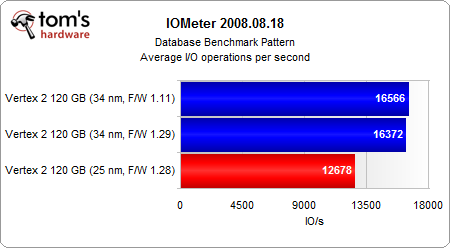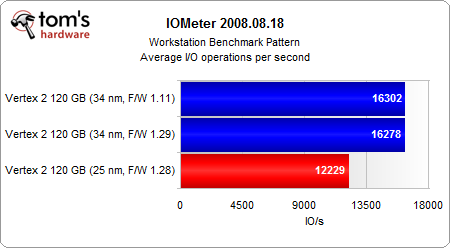The OCZ Vertex 2 Conspiracy: Lost Space, Lost Speed?
Several readers contacted me in the past two weeks, complaining about OCZ's recent adoption of 25 nm NAND and its effect on the capacity and performance of certain SSDs that they expected to be both larger and faster. I bought my own drives to compare.
Benchmark Results: I/O Performance
This is where processing could really come into play and affect our results. Notice that jumping all the way up from the 1.11 to 1.29 firmware revision has negligible effect on the 34 nm-based Vertex 2. However, the 25 nm drive gets, quite bluntly, hammered. For a product that is supposed to be the same, given its unchanged model number, that’s more than a little troubling to start things off.
OCZ saw the data, went to work on its firmware, and we’ll have to look forward to running it through its paces with optimized overhead.
The file server tests end similarly, with the 25 nm-based SSD losing 19% of its average IOPS.
We see the same thing in the Web server workload. A relatively similar speed loss in reading many small files is again consistent with overhead-imposed degradation attributable to heavier error checking.
The loss is more pronounced in the workstation workload, adding up to a 25% slide.
Get Tom's Hardware's best news and in-depth reviews, straight to your inbox.
Current page: Benchmark Results: I/O Performance
Prev Page Test Setup And Benchmarks Next Page Benchmark Results: Iometer Streaming-
Mushkin.com have a letter posted on the website that they will not be going to 25nm as the drives life cycle is less than half that of a 3*nm drive. Also the performance is not there.Reply
-
cangelini LeekayMushkin.com have a letter posted on the website that they will not be going to 25nm as the drives life cycle is less than half that of a 3*nm drive. Also the performance is not there.Reply
Depending on supply of 34 nm NAND, that's probably not a sustainable position to take. IMFT isn't going to decide to shift back to 34 nm.
At the risk of contradicting myself, Intel will be using 34 nm NAND on its next-gen 6 Gb/s Elmcrest drives. It's not like the flash isn't disappearing entirely, but the vendors making the switch seem to be motivated largely by cost-cutting reasons. -
Nicely done Mr. Angelini; however, I still think OCZ pulled a nasty car-salesman tactic on their newest 25 nm NAND SSD products, and as such will be looking elsewhere to purchase any future SSD. Blaming resellers or other sources for the SKU is an incompetent way of deflecting fault and has made them look even more silly.Reply
-
cangelini Thanks radiovan. Like I mentioned in the story, we'll have to see if companies like Corsair and Patriot are able to get their upcoming renamed SKUs onto Newegg, Tigerdirect, Zipzoom, etc.Reply -
1.29 Firmware....how nice... pity that ocz only documents 1.28 for the moment.Reply
And then again why not update the 25nm to 1.29 too?
But I guess consistency is not always wished when trying to demonstrate something -
nebun binoyskiOk, but when will we be able to buy ssd's that are $100 @ 1TB capacity?in about 10 years or so....that's a very big maybeReply -
yose3 binoyskiOk, but when will we be able to buy ssd's that are $100 @ 1TB capacity?Reply
when you throw a shoes to bush again meaby lol
-
Reynod It is all about profit.Reply
The real reason is that going to cheaper flash with a 3000 cycle life to reduce the total cost of production (and therefore increase profit) means ... increasing the amount of redundant memory to replace the flash that dies due to wear ... and that process means better error correction is required to achieve that ... therefore performance is effected.
Chris ... I got it into one sentence ... albeit a horrible one.
Nice article mate.




